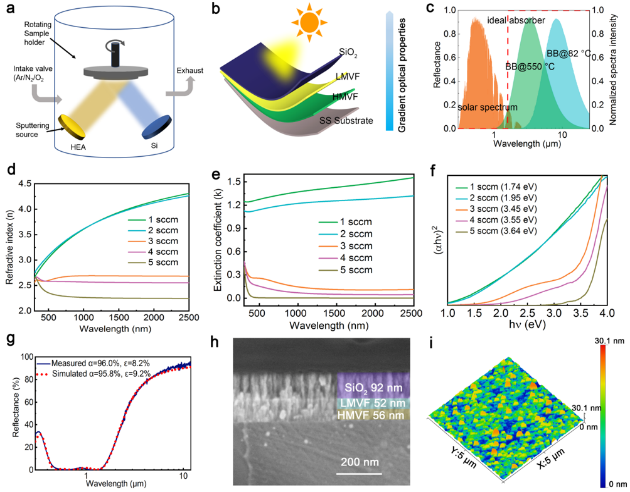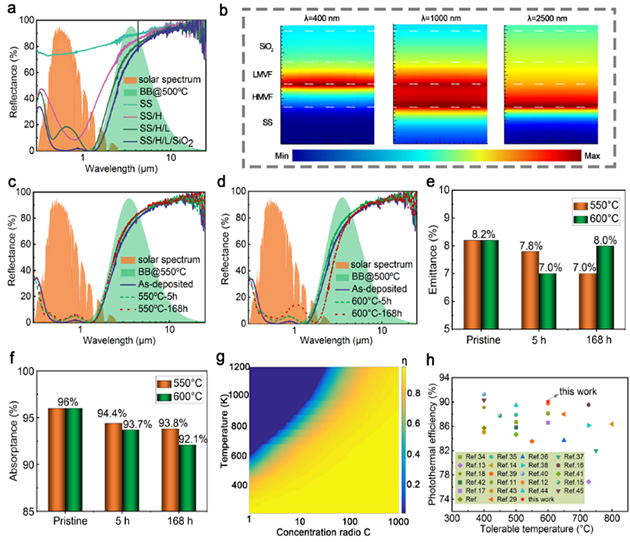As a newcomer in the alloy material world, high entropy alloys exceed the traditional alloy design concept as they possess more than 5 elements with a molar ratio of 5 ~ 35%, and generally exhibit a simple solid solution structure due to their high configuration entropy. With excellent mechanical properties, ability to withstand heat, as well as their resistance to wear, corrosion and irradiation, high entropy alloys promise great potential for development in the renewable energy industry.
Recently, a research team led by Associate Professor GAO Xianghu and Professor LIU Gang at the Research and Development Center for Eco-Chemistry and Eco-Materials, Lanzhou Institute of Chemical Physics,Chinese Academy of Sciences, has successfully prepared a series of high entropy alloy-based high temperature solar selective absorbing coatings through component modulation, conformational entropy optimization and structural design using high entropy nitrides.
Researchers have designed a color solar selective absorbing coating consisting of an infrared reflective layer of aluminum, high entropy alloy nitride, high entropy alloy nitrogen oxide and silicon dioxide, which enables a high solar absorption of 93.5% and a thermal emittance of less than 10%. The related research findings were published in Solar Energy Materials and Solar Cells (2020, 209, 110444), Solar Energy Materials and Solar Cells (2020, 217, 110709).
Subsequently, the researchers found that a single layer of high entropy alloy nitride ceramics also had good intrinsic absorption properties, and therefore prepared a coating with a simple structure. They used high entropy alloy nitride as the absorption layer and SiO2 or Si3N4 as the antireflective layer, and obtained a coating with an absorption of 92.8% and an emissivity of less than 7%, which showed favorable thermal stability in a vacuum at 650°C for 300 hours. The related research findings were published in the Journal of Materials Chemistry A (2021, 9, 6413-6422), ACS Applied Materials & Interfaces (2021, 13, 16987-16996), ACS Applied Energy Materials (2021, 4, 8801-8809).

Figure 1. High entropy alloy-based high-temperature solar selective absorbing coating enabled by a combination of optical simulation and magnetron sputtering.
To further enhance the absorption capacity of the absorber, the researchers chose stainless steel as the substrate, low-nitrogen content high entropy alloy films as the main absorption layer, high-nitrogen content high entropy alloy films as the extinction interference layer, and SiO2, Si3N4 or Al2O3 as the antireflection layer, forming a structure with gradually decreasing optical constants from the substrate to the surface (Figure 1). A combination of optical simulation and magnetron sputtering methods were used to improve the preparation efficiency, which contributed to an excellent solar absorption of 96% and a low thermal emission of less than 10%. The researchers further investigated the light absorption mechanism using the Finite-Difference Time-Domain (FDTD) simulation. After annealing for 168 hours at 600°C in a vacuum, the high entropy alloy nitride-based absorber still maintained good optical properties, indicating outstanding thermal stability. The photothermal conversion efficiency of the absorber was calculated at different operating temperatures and concentration ratios, and the efficiency was able to reach 90.1% when the operating temperature was 550°C and 100 suns. Compared with the state-of-the-art absorber reported recently, the high entropy alloy-based absorber exhibited both excellent photothermal conversion efficiency and thermal stability.

Figure 2. Study on spectral selective absorption mechanism and thermal stability.
The absorbers were deposited on different substrate materials, which maintained excellent optical properties, and achieved large-scale preparation on aluminum foil. Through the study of absorption spectra at different incident angles, it was found that the absorption coating had good absorption in the range of the incident light angle of 0-60°. Under radiation from simulated sunlight, the temperature of the coating surface exceeded 100℃, indicating that the material has great potential to be applied in the field of interfacial water evaporation. Relevant research findings were published in the Journal of Materials Chemistry A (2021, 9, 21270-21280), Solar RRL (2021, 5, 2000790) and Journal of Materials (2021, 7, 460-469 (invited)).
The above work has developed high temperature solar selective absorbing coatings with excellent optical properties and high temperature resistance, expanding the functional applications of high entropy alloys in the field of new energy materials. Dr. HE Chengyu is the primary author of the above paper.
This work was financially supported by the Youth Innovation Promotion Association CAS (2018455), the Regional Key Projects of the Science and Technology Service Network Program of the Chinese Academy of Sciences (KFJ-STSQYZD-139), and the Major Science and Technology Projects of Gansu Province (20ZD7GF011).
Contact:
Gao xianghu
Email: gaoxh@licp.cas.cn
Lanzhou Institute of Chemical Physics

